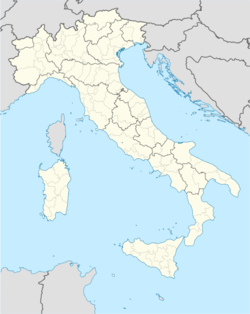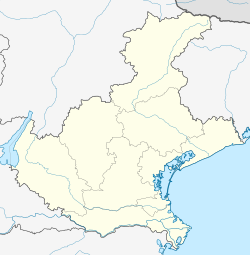كيودجا
كيودجا
Chioggia | |
|---|---|
| Città di Chioggia | |
 Aerial view of Chioggia | |
 Chioggia within the Province of Venice | |
| الإحداثيات: 45°13′11″N 12°16′44″E / 45.219643°N 12.278885°ECoordinates: 45°13′11″N 12°16′44″E / 45.219643°N 12.278885°E | |
| البلد | إيطاليا |
| المنطقة | Veneto |
| المدينة العمرانية | البندقية (VE) |
| Frazioni | Borgo San Giovanni, Brondolo, Cà Bianca, Cà Lino, Cavanella d'Adige, Isolaverde, Sant'Anna, Sottomarina,[1] Valli Di Chioggia |
| الحكومة | |
| • العمدة | Giuseppe Casson ([[قائمة الأحزاب السياسية في إيطاليا|PD]]) |
| المساحة | |
| • الإجمالي | 185 كم² (71 ميل²) |
| المنسوب | 2 m (7 ft) |
| التعداد (March 31, 2008) | |
| • الإجمالي | 50٬844 |
| • الكثافة | 270/km2 (710/sq mi) |
| صفة المواطن | Chioggiotti or Clodiensi |
| منطقة التوقيت | UTC+1 (CET) |
| • الصيف (التوقيت الصيفي) | UTC+2 (CEST) |
| الرمز البريدي | 30015, 30019, 30010 |
| مفتاح الهاتف | 041 |
| Patron saint | San Felice and San Fortunato |
| يوم القديس | June 11 |
| الموقع الإلكتروني | Official website |
كيودجا Chioggia مدينة شمال إيطاليا و في الجزء الجنوبي من إقليم فينيتو ، تقع في مقاطعة فينيسيا على ساحل البحر الأدرياتي ، تشتهر بالفنون ، وتعرف بفينيسيا الصغيرة لتشابههما في البناء في الوسط التاريخي و وجود قنوات عديدة بها و أهمها قناة فينا التي يقطعها تسعة جسور، يعتمد إقتصادها بشكل ر ئيسي على صيد الأسماك و إنتاج نوعية من الهندباء خاصة بها وعلى السياحة عدد سكانها 51.336 نسمة .

. . . . . . . . . . . . . . . . . . . . . . . . . . . . . . . . . . . . . . . . . . . . . . . . . . . . . . . . . . . . . . . . . . . . . . . . . . . . . . . . . . . . . . . . . . . . . . . . . . . . . . . . . . . . . . . . . . . . . . . . . . . . . . . . . . . . . . . . . . . . . . . . . . . . . . . . . . . . . . . . . . . . . . . .
الجغرافيا
The town is situated on a small island at the southern entrance to the Lagoon of Venice about 25 kilometres (16 miles) south of Venice[2] (50 km (31 mi) by road); causeways connect it to the mainland and to its frazione, nowadays a quarter, of Sottomarina. The population of the comune is around 50,000, with the town proper accounting for about half of that and Sottomarina for most of the rest.
The municipality, located in south of the province, close to the provinces of Padua and Rovigo, borders with Campagna Lupia, Cavarzere, Codevigo, Cona, Correzzola, Loreo, Rosolina and Venice.
التاريخ
Chioggia and Sottomarina were not prominent in antiquity, although they are first mentioned in Pliny[3] as the fossa Clodia. Local legend attributes this name to its founding by a Clodius, but the origin of this belief is not known.
The name of the town has changed often, being Clodia, Cluza, Clugia, Chiozza, Chiozzo,[4] Chioggio,[4] and Chioggia.[5] The most ancient documents naming Chioggia date from the 6th century AD, when it was part of the Byzantine Empire. Chioggia was destroyed by King Pippin of Italy in the 9th century, but rebuilt around a new industry based on salt pans. In the Middle Ages, Chioggia proper was known as Clugia major, whereas Clugia minor was a sand bar about 600 m further into the Adriatic. A free commune and an episcopal see from 1110, it had later an important role in the so-called War of Chioggia between Genoa and Venice, being conquered by Genoa in 1378 and finally by Venice in June 1380. Although the town remained largely autonomous, it was always thereafter subordinate to Venice. On 14 March 1381, Chioggia concluded an alliance with Zadar and Trogir against Venice, and finally Chioggia became better protected by Venice in 1412, because Šibenik became in 1412 the seat of the main customs office and the seat of the salt consumers office with a monopoly on the salt trade in Chioggia and on the whole Adriatic Sea.
الثقافة
Until the 19th century, women in Chioggia wore an outfit based on an apron which could be raised to serve as a veil. Chioggia is also known for lace-making; like Pellestrina, but unlike Burano, this lace is made using bobbins.
Chioggia served Carlo Goldoni as the setting of his play Le baruffe chiozzotte, one of the classics of Italian literature: a baruffa was a loud brawl, and chiozzotto (today more frequently chioggiotto in Italian, or cioxoto in Venetian) is the demonym for Chioggia. Goldoni took his setting seriously: the play is replete with lacemaking, fishermen, and other local color.
المعالم الرئيسية
Chioggia is often called "Little Venice", with a few canals, chief among them the Canale Vena, and the characteristic narrow streets known as calli. Chioggia has several medieval churches, much reworked in the period of its greatest prosperity in the 16th and 17th centuries.
The church dedicated to St. Mary of the Assumption, founded in the eleventh century, became a cathedral in 1110, then was rebuilt as Chioggia Cathedral from 1623 by Baldassarre Longhena.
The church of St. Andrew (18th century) has a bell tower from the 11th-12th centuries, the most ancient tower watch in the world. The interior has a Crucifixion by Palma the Elder.
الاقتصاد
Fishing is historically the livelihood of the port, and remains a significant economic sector. Other important modern industries include textiles, brick-making and steel; and Sottomarina, with 60 hotels and 17 campgrounds, is almost entirely given over to seafront tourism.
الديمغرافيا

التقاليد والفلكلور
During the third week end of June, the festival of Palio della Marciliana takes place.
Particularity of surnames
Chioggia represents an almost unique demographic case in Italy: the most common surname among the inhabitants of Chioggia is Zennaro, while the most common surnames of Sottomarina are Boscolo and Tiozzo.
Because of the large number of people with the same surname, the comune officialized what is known as "detto" (popular nicknames used to distinguish the various branches of the same family). These "third names" are inserted in every official document, including the driving license and the identity card.
أشخاص بارزون
- Jacopo De Dondi (1290–1359), doctor, astronomer and clock-maker
- Giovanni De Dondi (ca.1330 – 1388), an Italian physician, astronomer and mechanical engineer
- Niccolò de' Conti (ca.1395–1469), an Italian merchant, explorer, and writer.[6]
- John Cabot (1450 – ca.1500), an Italian navigator and explorer.[7]
- Gioseffo Zarlino (1517–1590), Italian musical theorist.[8]
- Rosalba Carriera (1673–1757), a Venetian Rococo painter.
- Stefano Andrea Renier (1759–1830), an Italian naturalist, zoologist and scientist
- Giuseppe Olivi (1769–1795), an Italian abbot and naturalist.
- Luigi Taccheo (1849–1940) an Italian pianist and composer
- Aristide Cavallari (1849–1914), a Cardinal of the Roman Catholic Church and Patriarch of Venice.
- Giuseppe Veronese (1854–1917), an Italian mathematician.
- Eugenio Bonivento (1880–1956), an Italian painter.
- Lina Merlin (1887–1979), an Italian politician, promoted "Merlin law"
- Bruno Maderna (1920–1973), an Italian conductor and composer.
العلاقات الدولية
بلدات توأم — مدن شقيقة
كيودجا متوأمة مع:
 لاميا (اليونان، 2007)
لاميا (اليونان، 2007) سان-تروپيه (فرنسا، 2008)
سان-تروپيه (فرنسا، 2008)
معلومات عامة
Chioggia gives its name to a variety of Beetroot, Radicchio (Italian chicory), and Pumpkin (Marina di Chioggia).
. . . . . . . . . . . . . . . . . . . . . . . . . . . . . . . . . . . . . . . . . . . . . . . . . . . . . . . . . . . . . . . . . . . . . . . . . . . . . . . . . . . . . . . . . . . . . . . . . . . . . . . . . . . . . . . . . . . . . . . . . . . . . . . . . . . . . . . . . . . . . . . . . . . . . . . . . . . . . . . . . . . . . . . .
الهامش
- ^ Nowadays a quarter
- ^
 Chisholm, Hugh, ed. (1911). . دائرة المعارف البريطانية. Vol. 6 (eleventh ed.). Cambridge University Press. pp. 235–236.
Chisholm, Hugh, ed. (1911). . دائرة المعارف البريطانية. Vol. 6 (eleventh ed.). Cambridge University Press. pp. 235–236. {{cite encyclopedia}}: Cite has empty unknown parameter:|coauthors=(help) - ^ NH III.xvi.121
- ^ أ ب Smellie, William, ed. (1771), "Chiozzo", Encyclopaedia Britannica, II (1st ed.), Edinburgh: Colin Macfarquhar.
- ^ History of Chioggia
- ^
 Beazley, Charles Raymond (1911). . In Chisholm, Hugh (ed.). دائرة المعارف البريطانية. Vol. 7 (eleventh ed.). Cambridge University Press. pp. 28–29.
Beazley, Charles Raymond (1911). . In Chisholm, Hugh (ed.). دائرة المعارف البريطانية. Vol. 7 (eleventh ed.). Cambridge University Press. pp. 28–29. {{cite encyclopedia}}: Cite has empty unknown parameter:|coauthors=(help) - ^
 Chisholm, Hugh, ed. (1911). . دائرة المعارف البريطانية. Vol. 4 (eleventh ed.). Cambridge University Press. pp. 921–923.
Chisholm, Hugh, ed. (1911). . دائرة المعارف البريطانية. Vol. 4 (eleventh ed.). Cambridge University Press. pp. 921–923. {{cite encyclopedia}}: Cite has empty unknown parameter:|coauthors=(help) - ^
 Chisholm, Hugh, ed. (1911). . دائرة المعارف البريطانية. Vol. 28 (eleventh ed.). Cambridge University Press. pp. 960–961.
Chisholm, Hugh, ed. (1911). . دائرة المعارف البريطانية. Vol. 28 (eleventh ed.). Cambridge University Press. pp. 960–961. {{cite encyclopedia}}: Cite has empty unknown parameter:|coauthors=(help)
وصلات خارجية
- صفحات تستخدم خطا زمنيا
- مقالات المعرفة المحتوية على معلومات من دائرة المعارف البريطانية طبعة 1911
- Short description is different from Wikidata
- Articles containing إيطالية-language text
- Coordinates on Wikidata
- Italian commune articles with missing parameters
- Pages using infobox Italian comune with unknown parameters
- Cities and towns in Veneto
- Communes of the Metropolitan City of Venice
- كيودجا
- مدن وبلدات في ڤنتو
- مدن إيطاليا
- صفحات مع الخرائط








